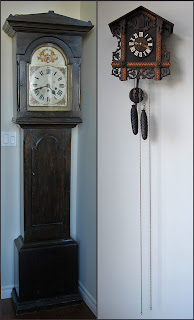Traditional timepieces
The Brits have the Great Clock atop Elizabeth Tower , Westminster Palace , London
Canadians have the Tower of Victory and Peace, which is more often called the Peace Tower , with its imposing gargoyles high above the Centre Block of Parliament Hill, Ottawa
Despite how large and bright today’s digital clocks shine, they pale compared to those classics.
Digital clocks are easy to read, but more often than not, they’re too bright (Times Square comes to mind). Then there’s the clamour of it all: alarms squawk, speak the hour or blare tunes at you.
How I long for the mechanical metronome-like pendulum tick-tock-tick-tock ticking accompanied by chimes, cuckoos, gongs and tolls. They’re loud, yet somehow soothing.
I grew up in households graced by those sounds, thanks to the two traditional timepieces shown here: the grandfather clock that towered in my grandparents’ foyer and my family’s cuckoo clock. They weren't merely antiques, those clocks were the heartbeat of our homes.
Even when these traditional timepieces get tired, they are striking.
Even when these traditional timepieces get tired, they are striking.
As the Austrian Baroness Marie von Ebner-Eschenbach originally wrote in German, “Even a stopped clock is right twice a day.”
The same cannot be said for digital clocks. They blank out. Many never even see replacement batteries before they're cast off.
Yes, traditional timepieces =
The same cannot be said for digital clocks. They blank out. Many never even see replacement batteries before they're cast off.
Yes, traditional timepieces =
What clock makes you tick?



Comments
Post a Comment